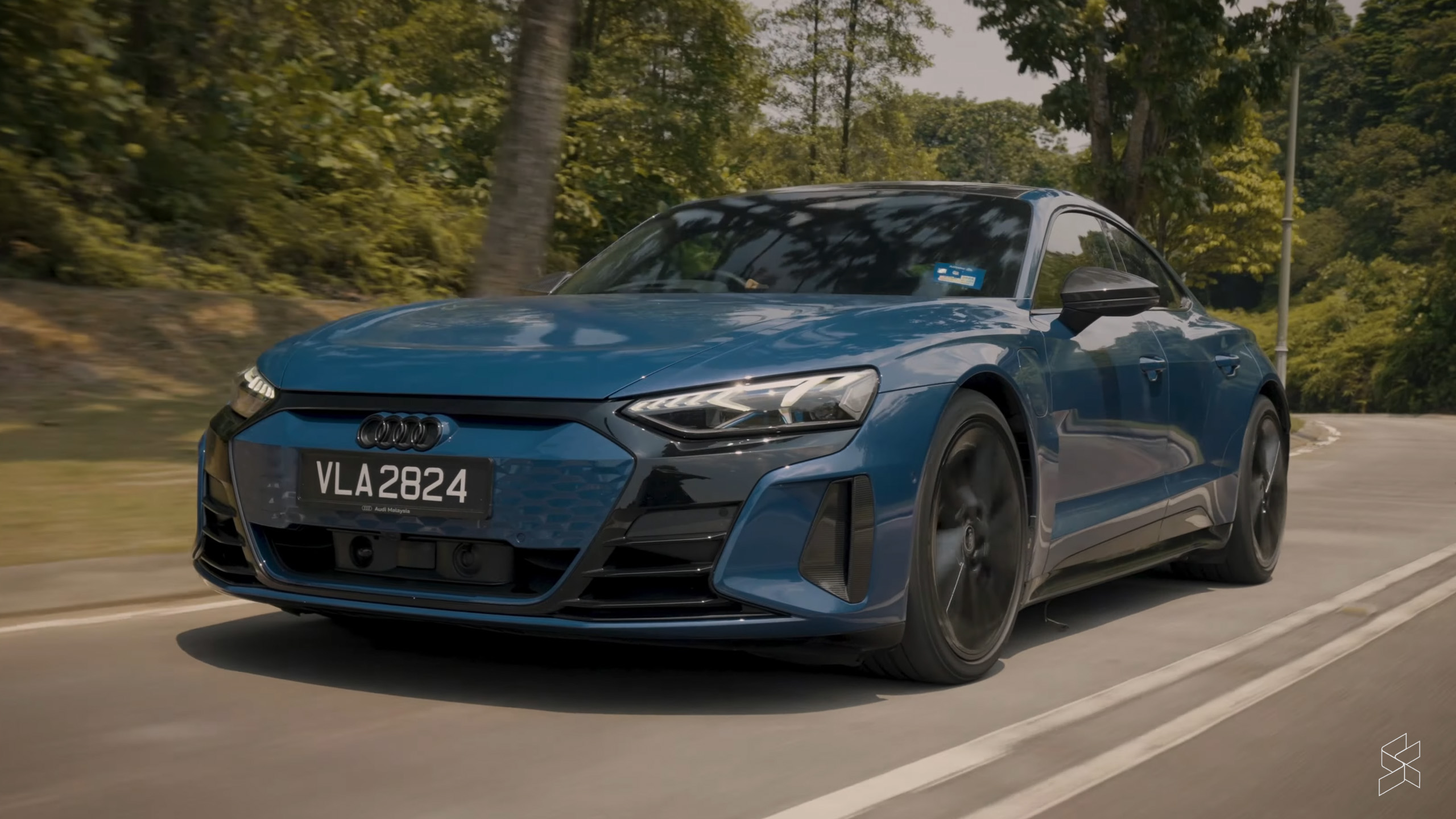The first thing you need to understand about the Audi RS e-tron GT, Ingolstadt’s first properly high-performance electric car, is that you can’t compare it to any other EV. Even tax free, it costs a staggering RM803,990—well beyond most other models being sold in Malaysia. It also puts the car up against some serious petrol-powered competition.
And on paper, there isn’t much to suggest that it’s worth all that money. It’s not the quickest, nor the most powerful. It doesn’t offer all that much space, and it doesn’t even try to dazzle you with its tech. In fact, you might wonder why you’d even buy this car in the first place.
There is one very good reason, however: it’s really f***king fast.
Speed demon

The standard e-tron GT quattro already produces an impressive 350kW (469hp) and 630Nm of torque from its dual electric motors, but the RS model twirls the dial all the way up to 11. Outputs are rated at a massive 440kW (590hp) and 830Nm, enough to get the car from zero to 100km/h in 3.6 seconds.
And if you are clinically insane, you can go even faster than that. Thumb the drive select button to engage dynamic mode, apply the brakes and floor the throttle, and the RS e-tron GT goes into launch control. This primes the motors to send a stratospheric 475kW (630hp) to all four wheels, setting up this big four door to rocket forwards with alarming alacrity the second you lift off the brakes.
Audi claims that with launch control engaged, the RS e-tron GT will get from zero to 100km/h in just 3.3 seconds, but in our experience the car will go even quicker than that. And it seems like the worse the conditions, the quicker it will go—on a slightly damp surface, the RS e-tron GT ripped off a century sprint in three seconds flat. At the end of it all, you’re left flabbergasted by how much traction it can claw from the ground beneath it.
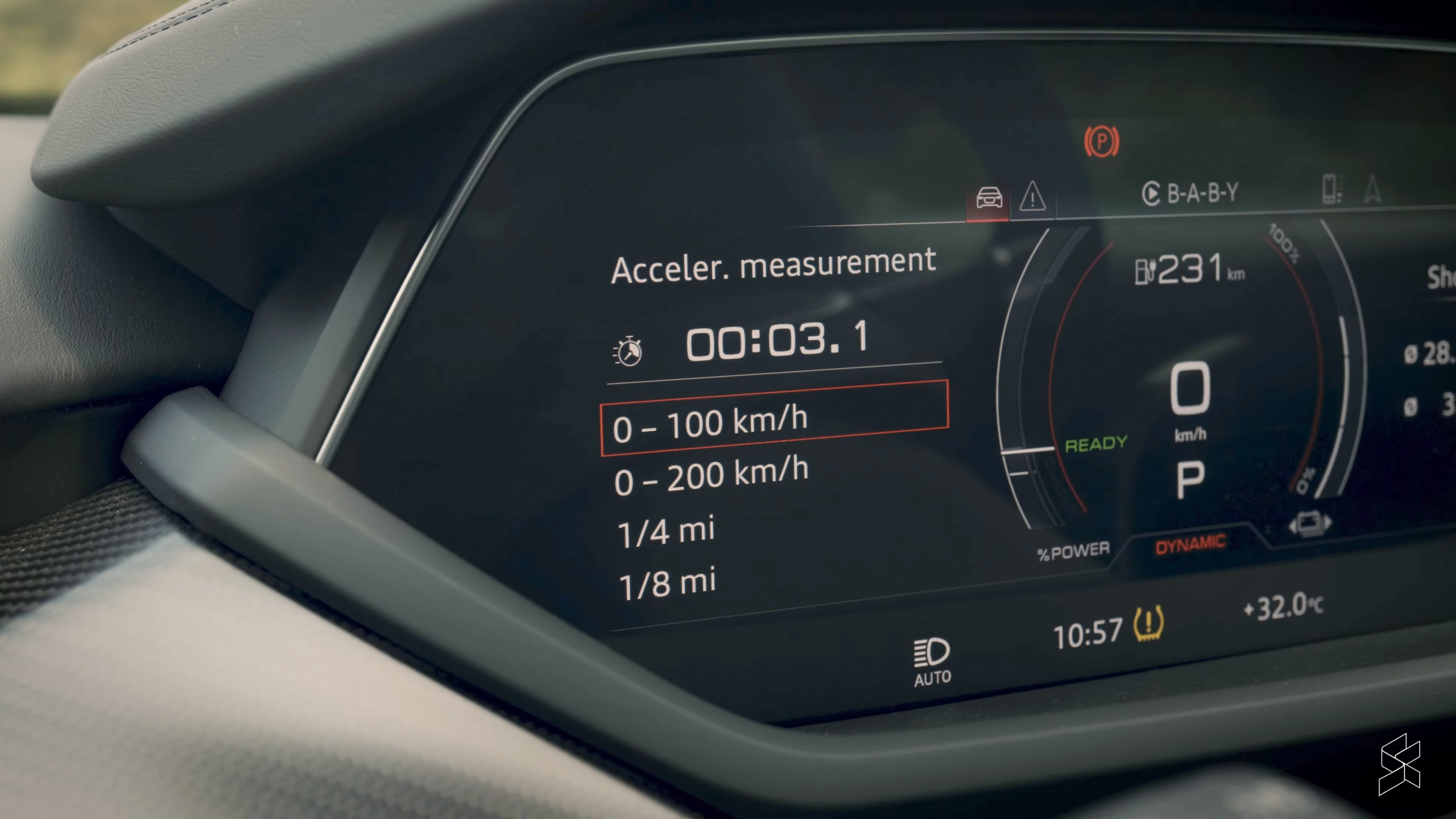
Of course, acceleration from a standing start is one thing—any EV worth its salt can do it quickly. In fact, there are a number of them—notably the also-expensive Lotus Eletre R SUV—that will beat the Audi to the 100km/h mark. What really sets the RS e-tron GT apart from the others is how it keeps on pulling even beyond highway speeds.
There is simply no let up. Whereas other EVs will run out of puff beyond 160km/h, the RS e-tron GT finds a second wind; achieving big speeds in this car is simply effortless. Audi says it will get to 200km/h in just 10.9 seconds—on its way to an electronically-limited top speed of 250km/h—and it feels every bit as fast as that. The right pedal isn’t so much a throttle as it is a hyperspace button.
Audi badge, Porsche bones
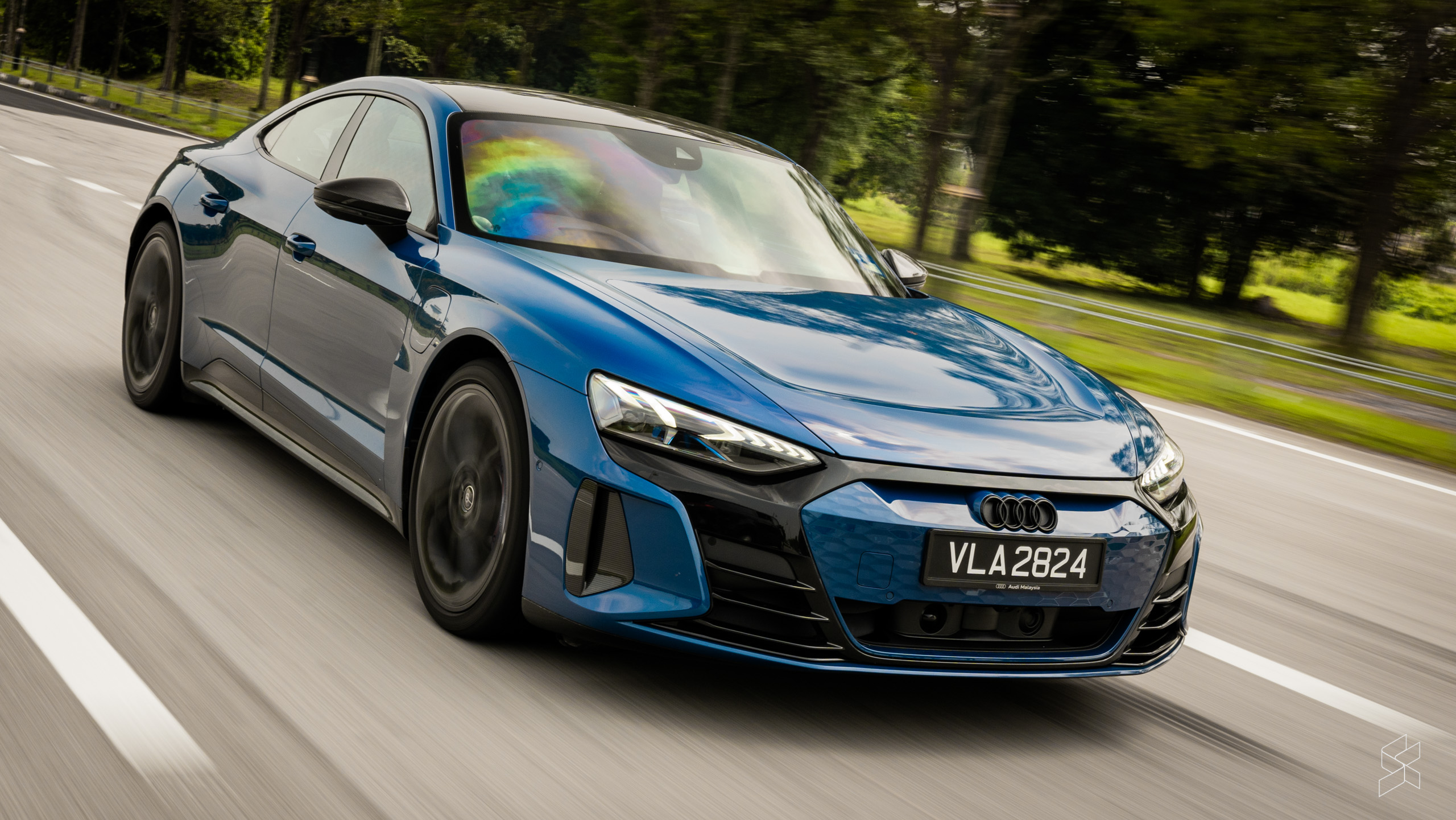
The reason for this second wind is the two-speed gearbox at the back of the car, and under sustained hard acceleration, you can actually feel the shunt in your back as this EV shifts gears. If this sounds familiar, that’s because this gearbox is shared with the Porsche Taycan, and this is where we come to the elephant in the room.
In fact, the whole car is simply a Taycan with four rings on it. It shares the same J1 platform, motors, battery and much of the running gear; even the windows are the same as what you’d find on the Porsche. It really makes you wonder how much of the RS e-tron GT is Audi’s own handiwork.
Worse still, the Taycan isn’t a million miles away in price. The Turbo model is slightly more powerful (500kW or 670hp with launch control enabled) and costs just RM60,000 more. Of course, once you spec the Porsche to match the Audi’s considerable level of standard equipment, you’re looking at a bill of over a million ringgit, but my point still stands—especially as you’d be driving a Porsche instead of an Audi.
But however cynically you think about the wider Volkswagen Group’s badge engineering practices, building an Audi using Porsche bones does have one undeniable effect—this car is fantastic to drive.
Engaging handling—up to a point
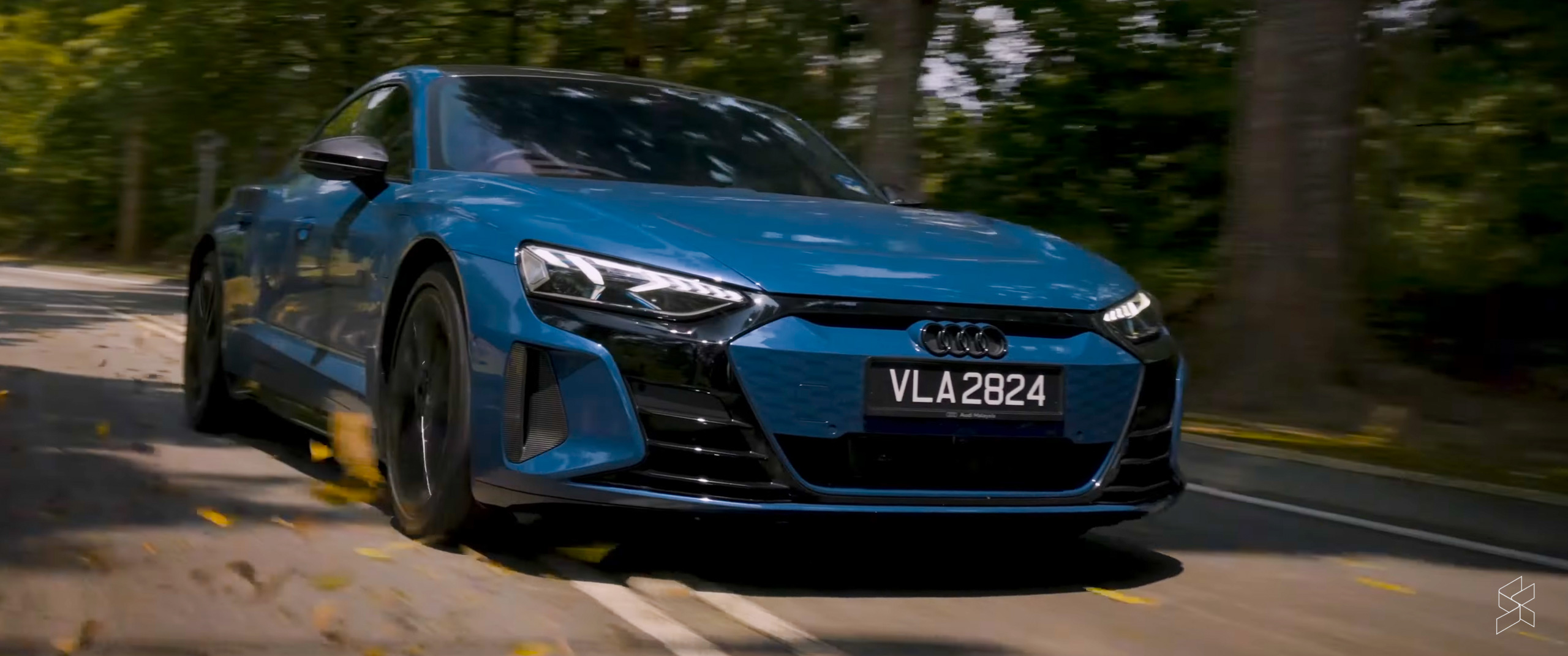
It helps that the RS e-tron GT is packed full of physics-defying chassis tech. Peer under the skin and you’ll find adaptive air suspension and active roll stabilisation, while the back end has been outfitted with rear-wheel steering and a locking differential. Put all that together and the effect is profound.
Flick the steering wheel and you’ll find that despite the variable-ratio steering, the car changes direction exactly as to your inputs, and even with electric assistance there’s some actual feel coming through the rim. The rear axle tech also imbue this long and heavy sedan with more agility than it has any right to have, and in slower corners you can even get the back end to step out.
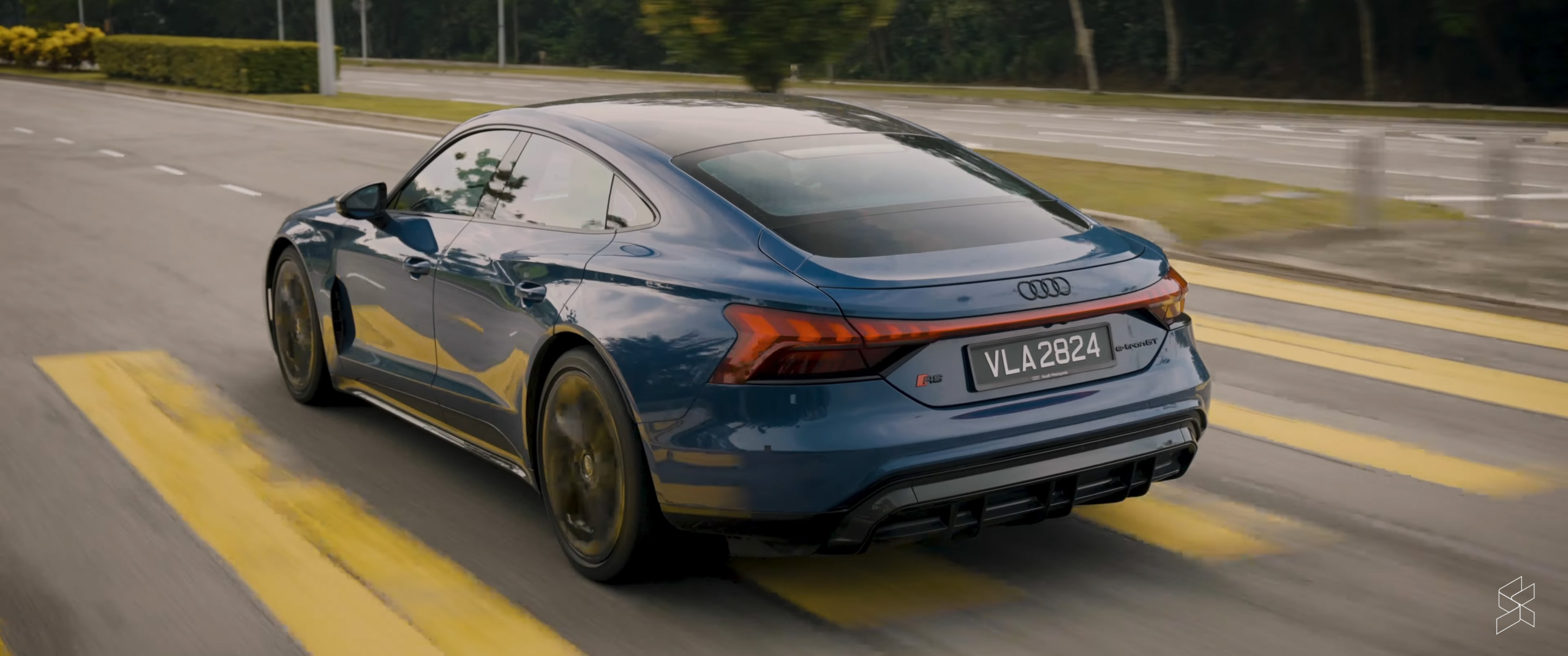
But at some point the RS e-tron GT simply cannot run away from the sheer laws of physics. Drive it by the scruff of its neck and you’re suddenly made aware of just how much mass you’re carrying (nearly two and a half tonnes, in case you’re wondering). There’s quite a bit of unhelpful body roll when you’re pushing to the absolute limit, and eventually all-wheel-drive system and trick rear differential simply give up and the car just understeers.
The RS e-tron GT’s sheer speed exposes another weakness—its brakes. Yes, it comes with massive tungsten carbide brakes, but it takes a huge effort to get the car to stop; you can blame the extremely long pedal for that. Exacerbating the issue is the fact that, by default, there’s no regenerative braking when you lift off the throttle, and while we’re at it, the transition between regenerative and friction braking when you hit the middle pedal isn’t as smooth as it could be. Not the most reassuring feeling when you’re carrying big speeds.
There’s another problem when you’re driving quickly: the RS e-tron GT uses a lot of electricity.
Poor efficiency, but fast charging makes up for it
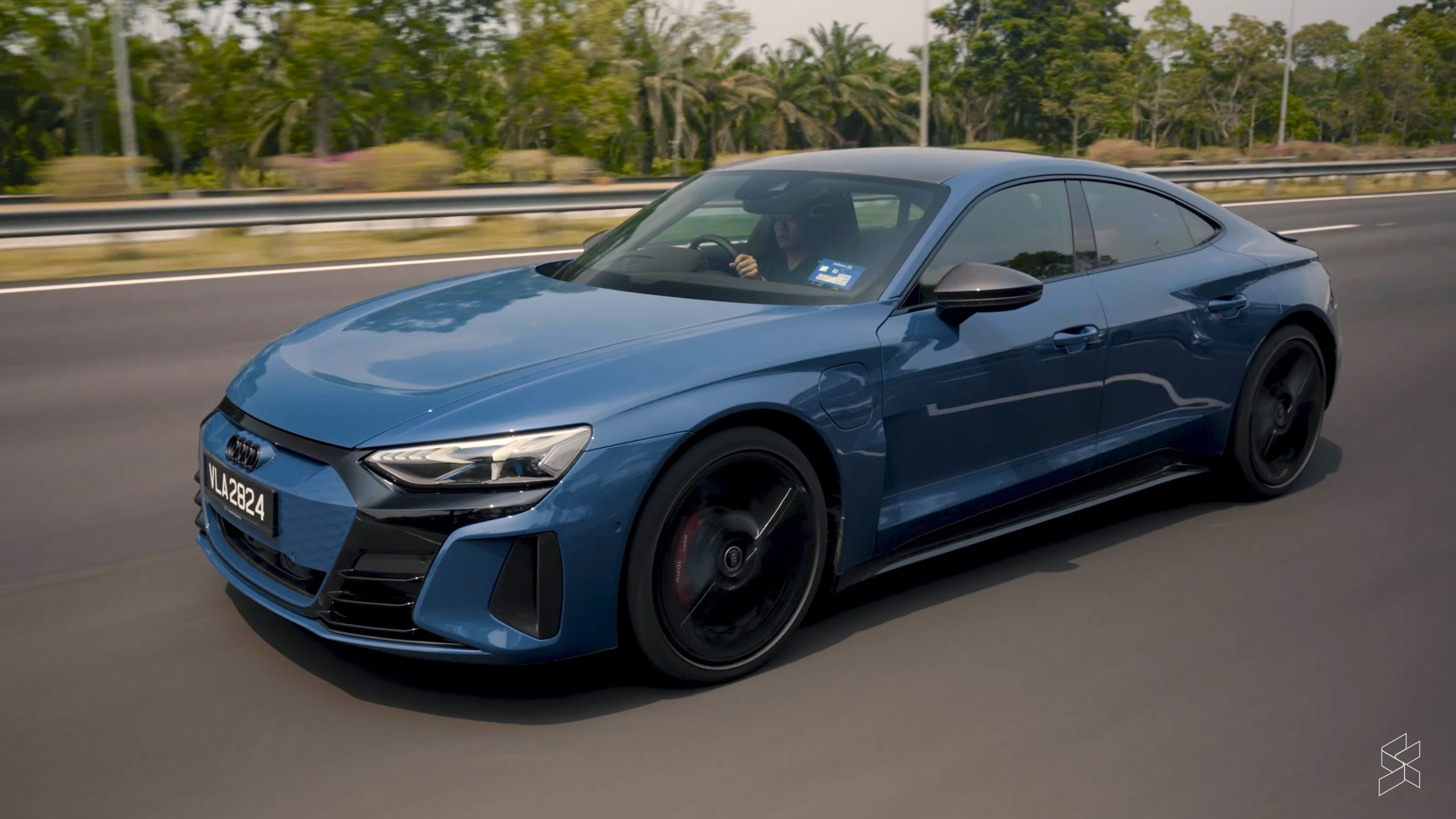
At first glance, the RS e-tron GT’s 93.4kWh battery seems generous, but you’ll quickly discover that the car needs every kilowatt-hour just to provide a usable amount of range. The Audi’s efficiency is, to use a technical term, simply awful: at no point did its energy consumption ever dip below 20kWh per 100km—even with very careful driving—and if you use any of the performance on tap, even getting below 30kWh per 100km will be a struggle.
Audi claims a WLTP-rated range of 495km, but realistically you’re looking at a figure closer to 400km—and much, much less if you cane it. It’s a real shame: the company’s usage of the GT (or grand tourer) moniker implies the ability to travel long distances at high speeds, but the car simply doesn’t have the legs to do so.
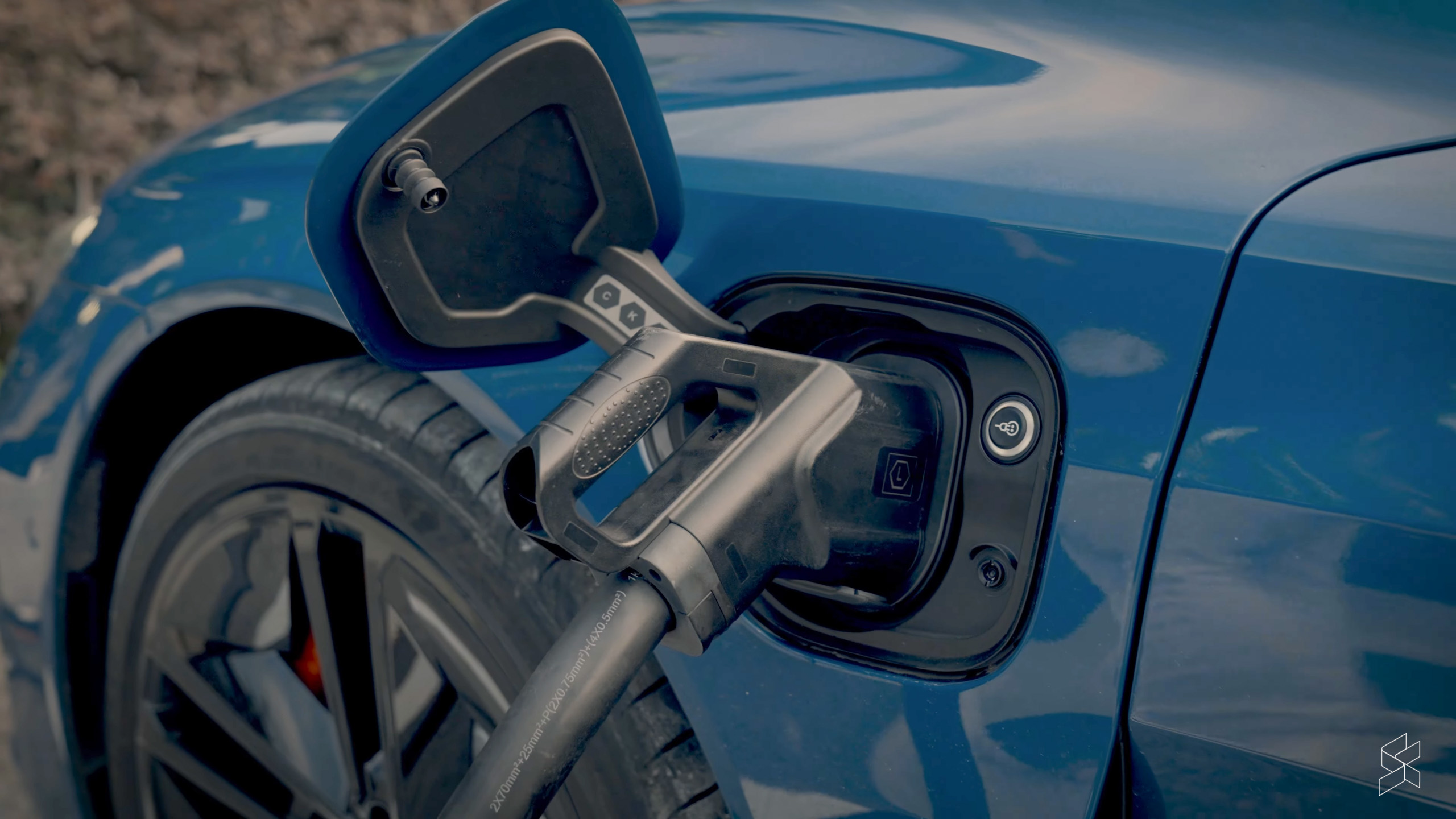
Happily, however, the RS e-tron GT does come with an 800-volt architecture, meaning it can support up to 270kW of DC fast charging. This fills up the big battery from five to 80% in just 22.5 minutes. The car can also accept the fastest 22kW AC wallbox chargers, providing a full charge in around nine hours. As such, the way to get around the efficiency problem is to just drive faster and charge more often.
And when you are charging it, you get to enjoy the Audi’s typically excellent interior.
Surprisingly analogue interior
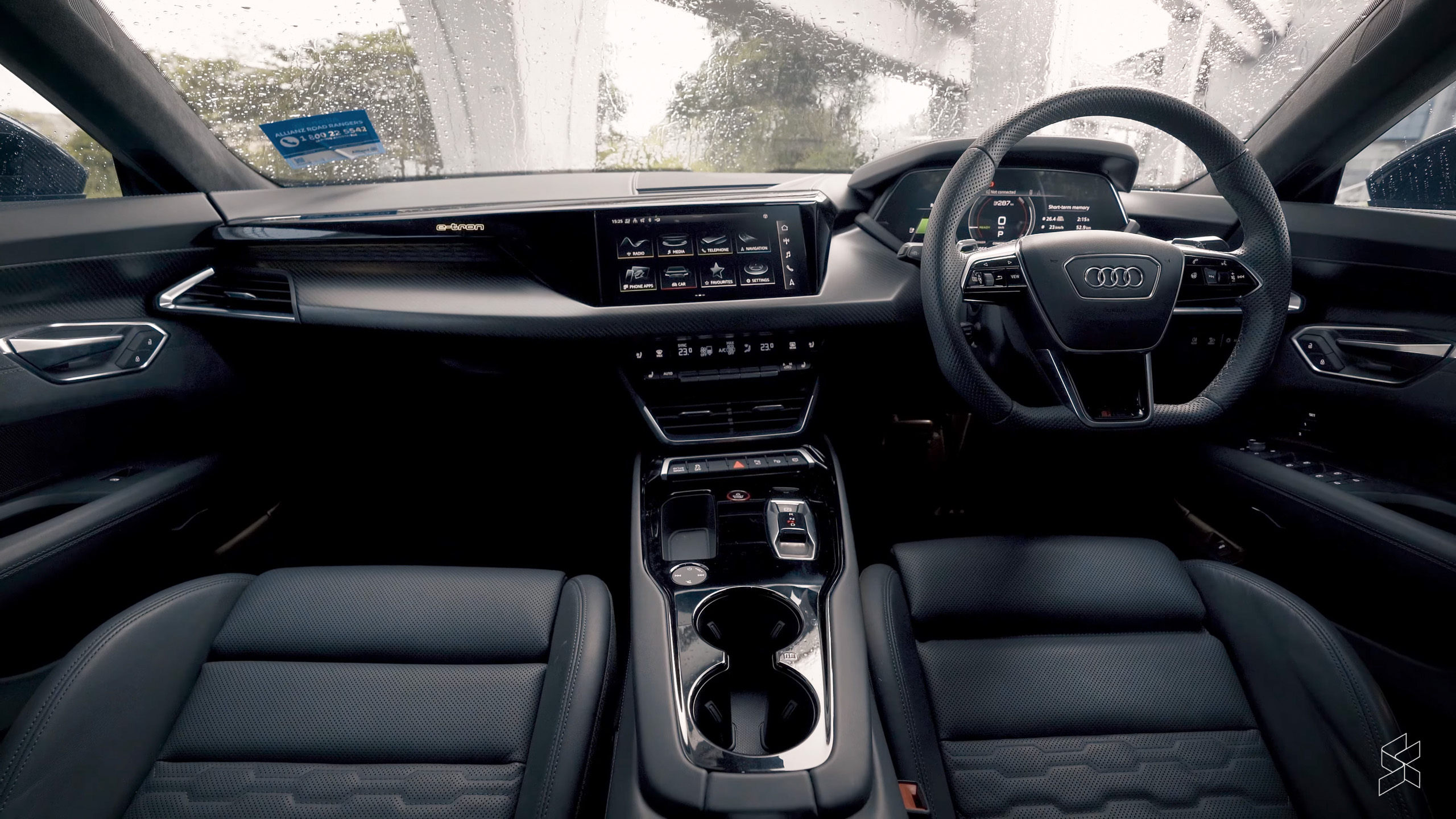
The RS e-tron GT possesses the Teutonic build quality you’d expect—just as well given the price of the car. Everything feels like they will last a lifetime, and you won’t find much in the way of hard, scratchy plastics. And of course, the are plenty of RS badges to remind you of what you’re sitting in. You know, just in case you forgot how much you splurged on the thing.
There is, however, a niggling feeling that this interior isn’t quite special enough for the money. Yes, the RS e-tron GT has acres of carbon fibre and Alcantara, along with lots of plush Nappa leather on the seats, steering wheel, dashboard and door cards. But there isn’t much flair in the design, the standard all-black colour scheme makes the cabin look a little dour and the ambient lighting system isn’t as showy as what you’d find in a BMW or Mercedes these days.
The Audi does claw back some brownie points in other areas. Given the company’s propensity for fitting touchscreens everywhere and the fact that the car is based on the Taycan, you might expect the RS e-tron GT to come with a wall of screens and a complete lack of physical controls. But this cabin is refreshingly simple.
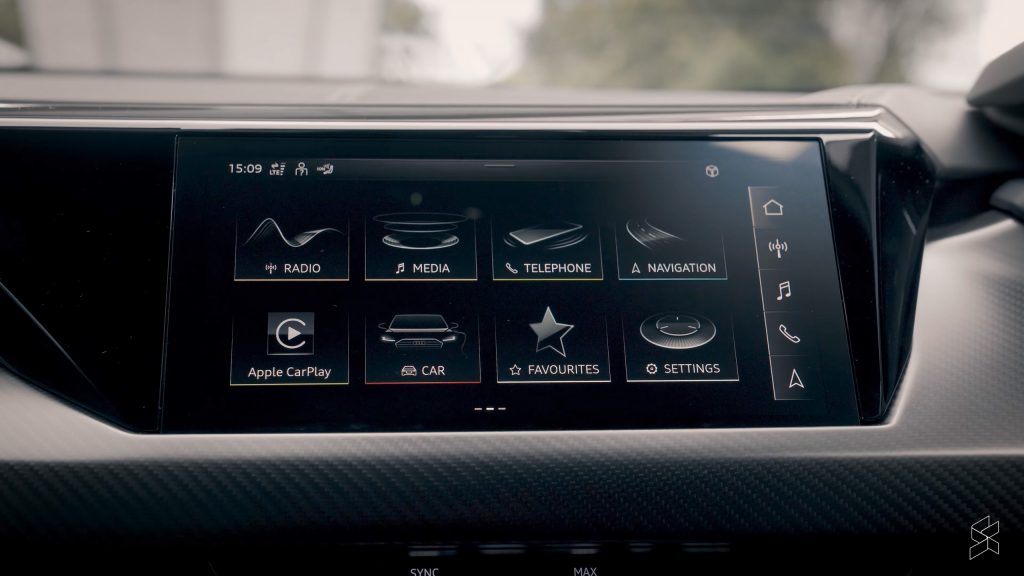
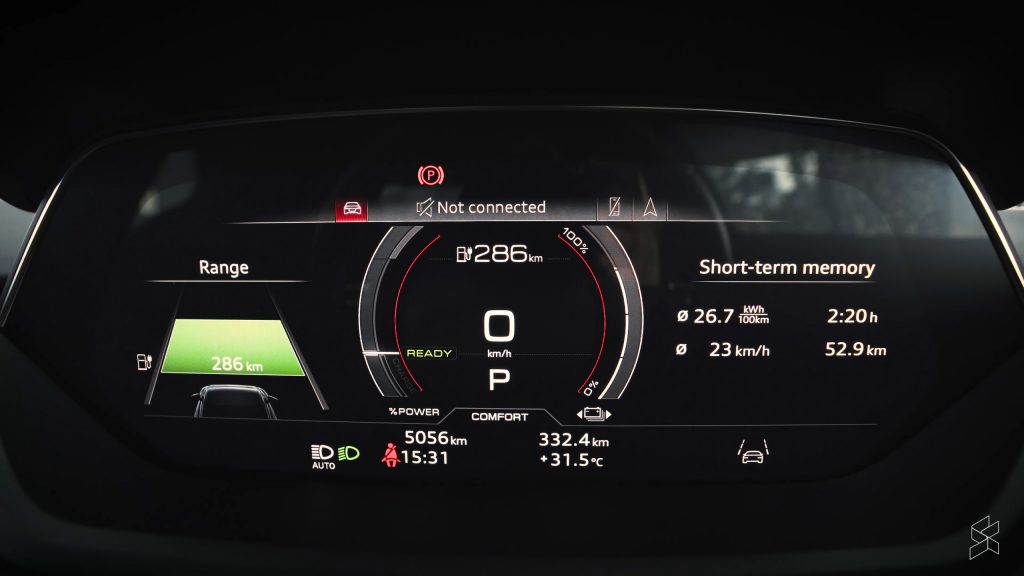
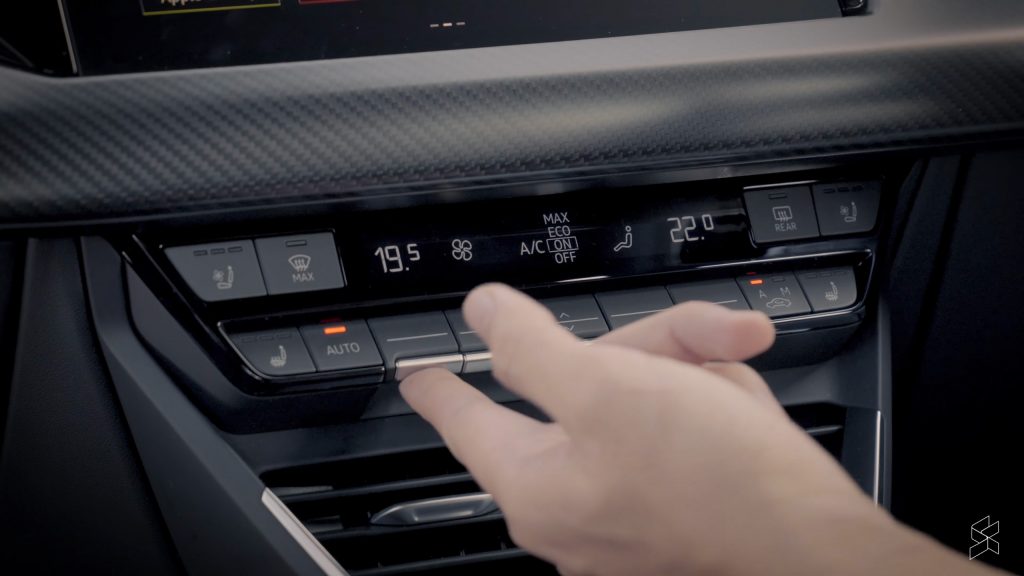
Yes, the car isn’t short on tech—there’s a big 12.3-inch Audi virtual cockpit instrument display, a head-up display, a (rather small) 10.25-inch centre touchscreen, wireless Apple CarPlay and Android Auto and a brilliant 16-speaker Bang & Olufsen 3D sound system. But there’s no separate display for the passenger, the air vents are (thankfully) adjustable by hand and there are plenty of hard buttons on the steering wheel and for the air con. It’s odd to be mentioning these things in a car review, but that’s the state of the world we live in right now.
But, just like the rest of the car, there are faults. Some areas of this interior are a bit too old school for their own good. For instance, the calculator-style climate control LCD is a bit ’80s and the cheap-feeling stalk for the adaptive cruise control looks like it came from a mid-2000s Audi A4. Worse still, the RS e-tron GT does not come with lane centring assist—a baffling omission on an RM800,000 car. And incredulously for a car sold in 2024, there is a curious lack of storage space for a smartphone.
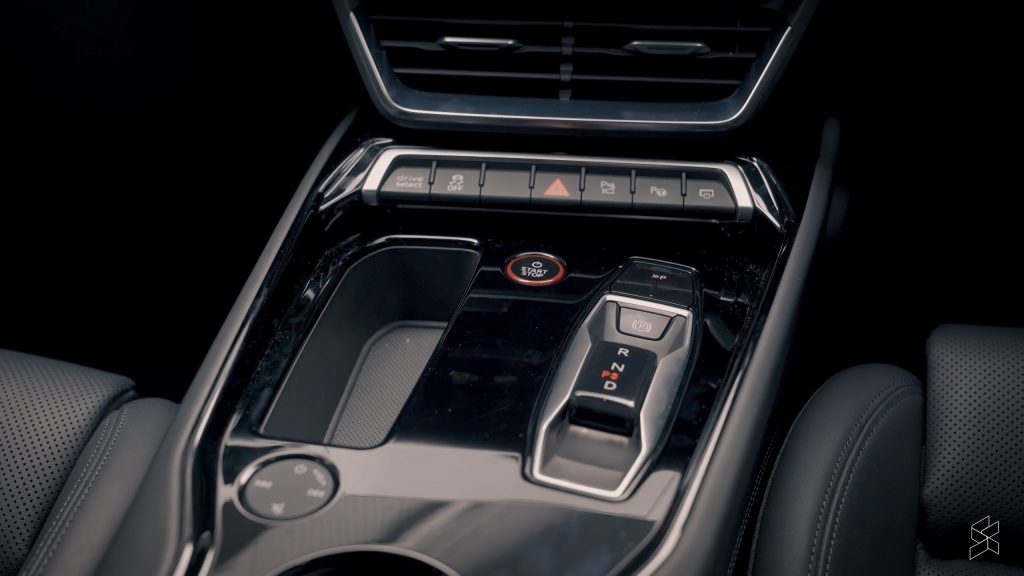
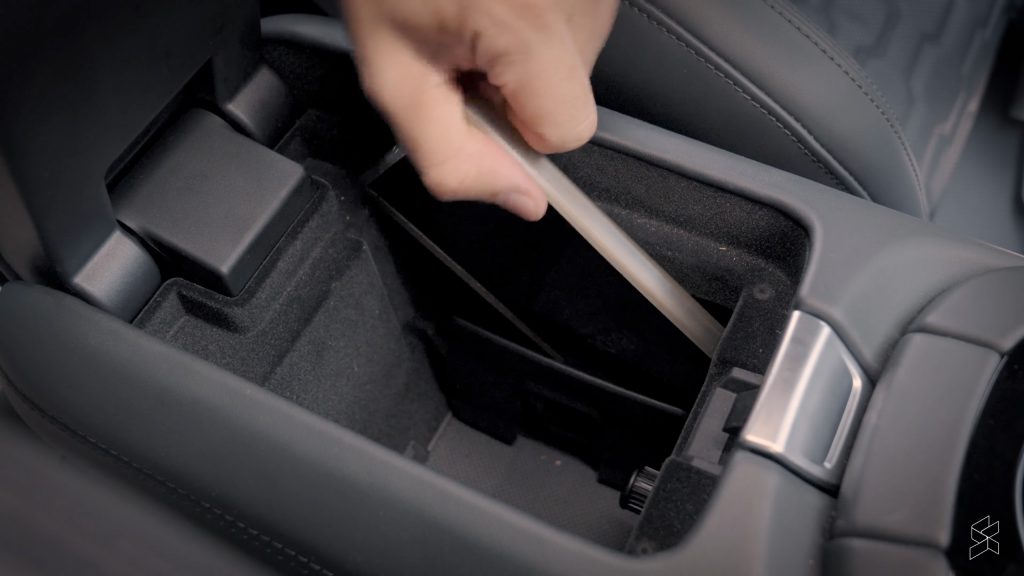
The few cubby holes that do exist in this cabin are very mean, being neither long nor deep enough to hold anything other than small change. And even though the armrest hides twin USB-C charging ports, the space that holds them is so small that you simply can’t fit a charging cable and a phone all at once. That means the only real way to charge your phone is by using the stupidest wireless charger on the planet.
It runs underneath the centre console, and to use it at all you’ll have to aim your phone through a tiny opening underneath the armrest. And if you’re using a truly big phone—such as a Samsung Galaxy S23 or S24 Ultra—with a case on, it won’t fit at all. Whose bright idea was this?
Other niggles? You sit low in the car, which is great, but the cushion bolsters rise so high up that getting in and out of the seats is a struggle. And yet, the side bolsters offer surprisingly little in the way of lateral support—weird for a performance-oriented machine.
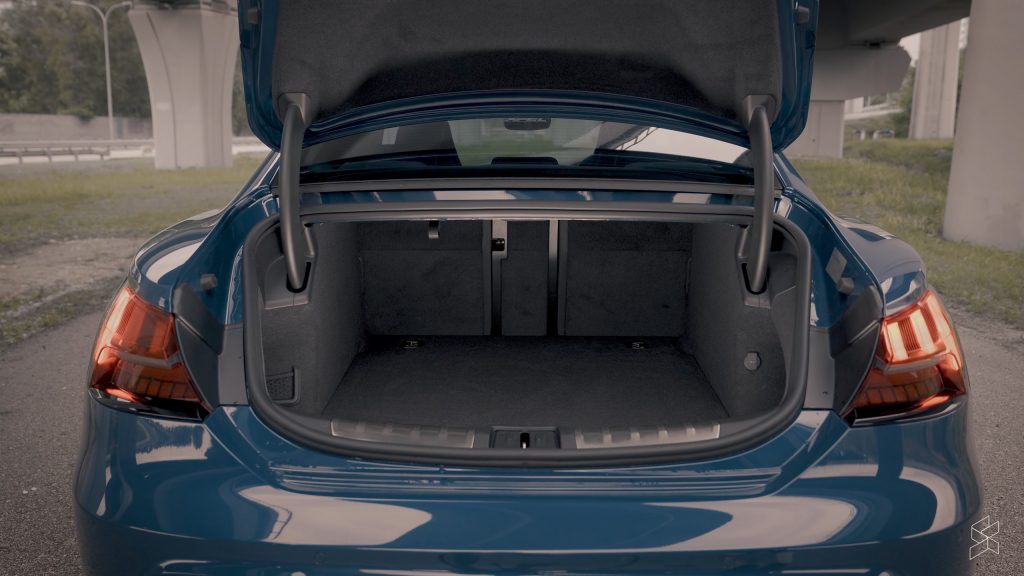
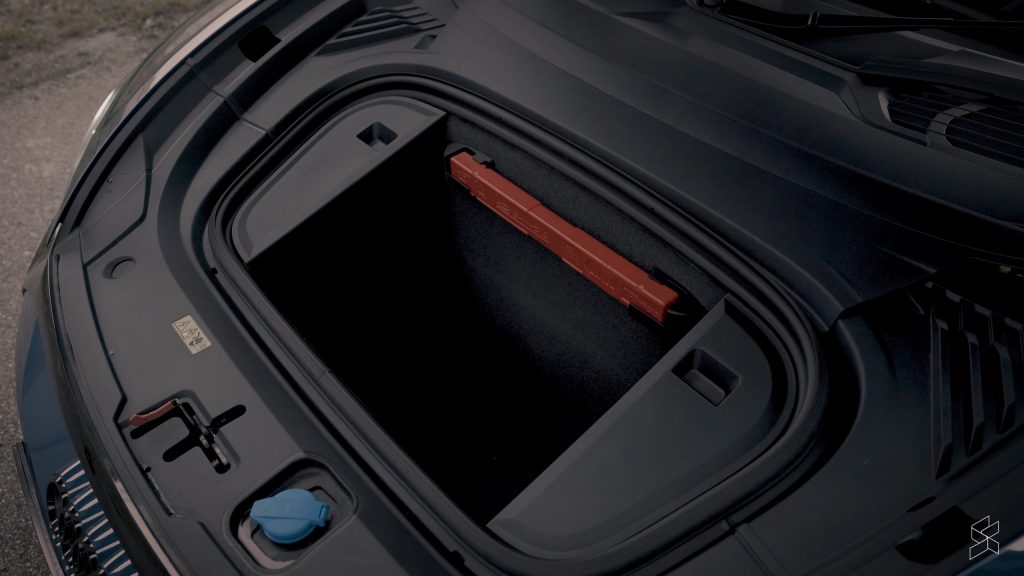
Like the Taycan, the RS e-tron GT offers decent but not exceptional amount of room for those at the back. Headroom is naturally a little tight due to the low-slung roofline, and as is becoming the norm for electric cars, the high floor pushes your knees up, making the rear seats a bit uncomfortable to sit in on long journeys. But you do at least get your own air con vents, temperature controls, cupholders and USB-C ports—not exactly a given in coupé-style four-doors like this one.
The Audi also offers a deep if slightly narrow boot. At 366 litres in the RS version, it’s not the most capacious in the segment, but there is a sizeable 85-litre front boot—more than enough to store your charging cables. Overall, despite all my complaints, the RS e-tron GT is a surprisingly pleasant car to live with day-to-day.
And there is one area where this car is simply beyond reproach.
Knockout styling, sublime ride comfort

The Audi’s exterior design alone might be worth the price of admission. Styled by Parys Cybulski and Lucia Lee under the watchful eye of design boss Marc Lichte, the RS e-tron GT retains the Taycan’s basic proportions—it’s impossibly long and low with a gently-sloping roofline. Yet it manages to avoid being a facsimile of the Porsche, with sharper lines next to the slightly bulbous look of its sibling.
There’s real structure to the design, most evident in the muscular, deliciously-sculpted haunches. This car exudes presence, especially with the standard 21-inch alloy wheels. And that’s before you get into details like the intricate laser headlights, or the full-width taillights that play an eye-catching animation when the car is locked and unlocked. This is one of those rare cars that demands you turn back for one more look before walking away.
If I have one complaint—and it is a minor one—it’s that the front end is just a bit too busy. There are no less than six air inlets, which is just too many, and even though Audi has tried to tie them all together with a gloss black mask, the RS e-tron GT lacks the restrained aggression found on past RS models. Even so, there’s no way to describe the car other than it being a complete stunner—one that turns heads everywhere.
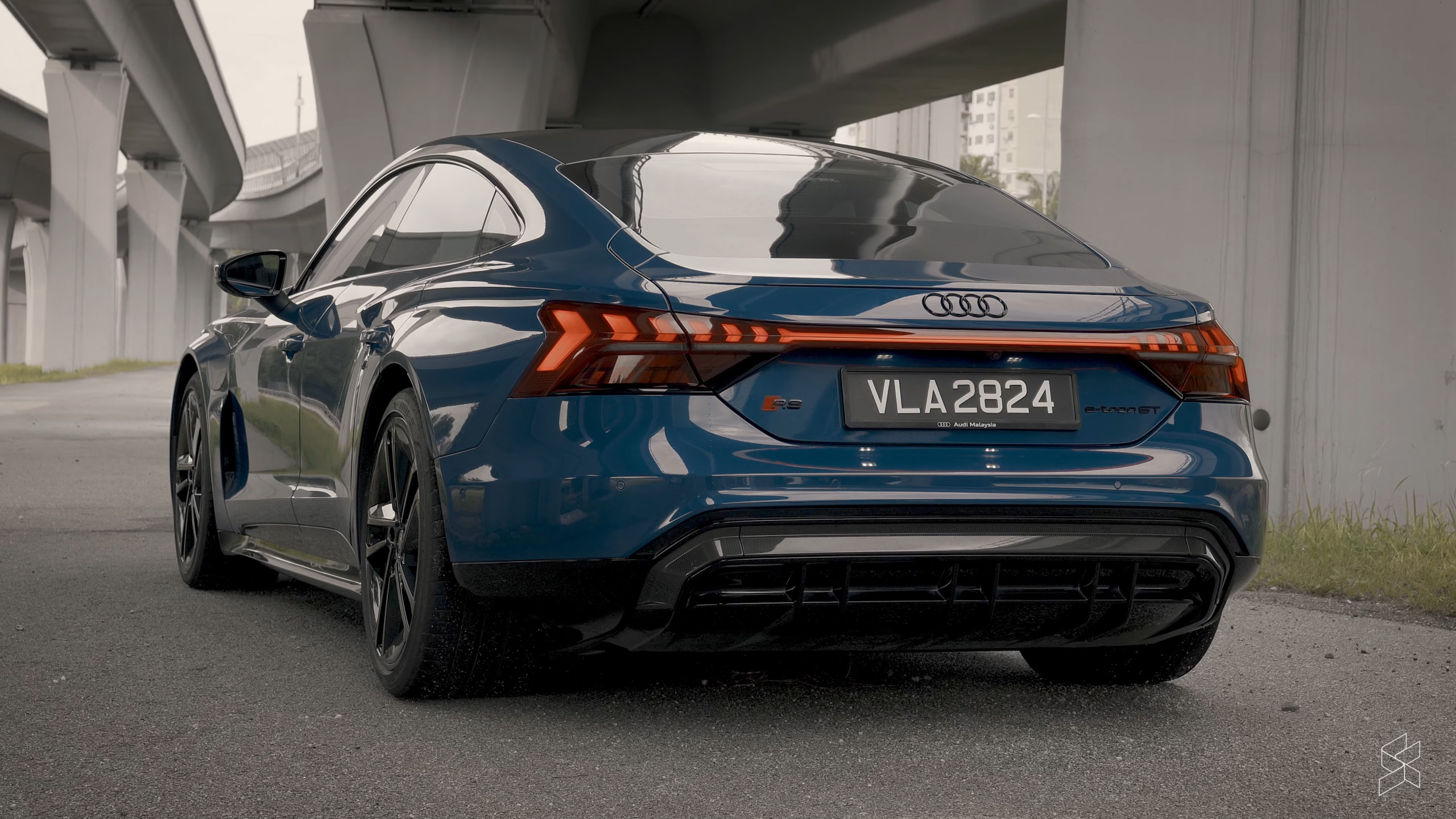
And we haven’t gotten to the best part: the adaptive air suspension provides the RS e-tron GT with an exceedingly supple ride for a performance car. Yes, there is an underlying firmness, so speed bumps are merely smoothened out rather than flattened entirely, but the faster you go, the better it gets. Even in dynamic mode, large craters and undulations simply fail to faze the car, and yet its body control remains impeccable in the bends.
Dynamically, the RS e-tron GT is remarkably free of vices, making it a great piece of transport whether you’re stuck in traffic jam, cruising on a highway or enjoying a blast down a twisty road. Only when you’re driving it at ten-tenths—at speeds that are simply antisocial on the public road—does it feel out of depth. It is a big car, however; tight parking spaces are a real pain to manoeuvre in and out of.
Oh well, nothing’s perfect.
An EV with character, warts and all

Make no mistake, the Audi RS e-tron GT is not perfect. There are many things it struggles at, not least of which being its rather ineffective brakes, terribly poor efficiency and chronic lack of practical interior storage. And that, I argue, is exactly the point of a car like this.
We expect our EVs to be perfect these days. We want the most power, the longest range, the most practical interior and the best charging infrastructure to back it all up—which is why a Tesla is the default choice. But as good as a Tesla is, it’s also incredibly dull (no, the farting and juvenile Elon Musk humour don’t change that), and the world needs EVs that are the opposite of that.
That’s where the RS e-tron GT comes in. It’s a car with incredible strengths and considerable weaknesses, and that gives it character in spades. All that devastating speed, those attention-grabbing looks, even that deep piped-in rumble you can hear when the car moves slowly—they all get under your skin.
This is the first EV you buy not with your head, but with your heart. It makes you feel like a superhero when it sings and that, I think, says it all. And while all those things can also be levelled at the Taycan, the Audi is cheaper and better looking. If I won the lottery tomorrow, this might be the car I’d spend it all on.

